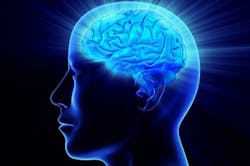DARPA seeks human brain-like computers for complex signal processing and data analysis
ARLINGTON, Va., 20 Aug. 2013. U.S. government computer scientists are trying to emulate human brain functions in advanced computing, and applying this approach to complex signal processing and data analysis.
Officials of the U.S. Defense Advanced Research Projects Agency (DARPA) in Arlington, Va., have issued a request for information (DARPA-SN-13-46) for technologies related to developing a computer that emulates the human brain in a cortical processor.
The DARPA Microsystems Technology Office (MTO) is asking industry and academia for information on cortical processing technologies and applications that may support a new DARPA program in complex signal processing and data analysis.
Although not a neuroscience project per se, this project will depend heavily on a variety of neural models derived from the computational neuroscience of neocortex, DARPA researchers say.
Capturing complex spatial and temporal structure in high-bandwidth, noisy, ambiguous data streams is a significant challenge in even the most modern signal and image analysis systems, researchers say.
Current computational approaches are overwhelmingly compute-intensive, and are able only to extract limited spatial structure from modest quantities of data. Present-day machine intelligence, meanwhile, is even more challenged by anomaly detection, which requires recognition of all aspects of a normal signal, to determine those parts that do not fit.
Instead, DARPA researchers are looking for new approaches, based on high capacity, low power implementations. Approaches today, which include machine learning, Bayesian techniques, and graphical knowledge structures, provide partial solutions to this problem, but are limited in their ability to scale efficiently to larger more complex data sets.
Not only are today's approaches compute-intensive, but they also exhibit limited parallelism, require high precision arithmetic, and in most cases do not account for temporal data, DARPA researchers explain.
A new approach could be based on the brains of humans and other mammals, which efficiently captures spatial and temporal structure and routinely solves extraordinarily difficult recognition problems in real-time.
Although a thorough understanding of how the cortex works is beyond current state of the art, researchers are starting to identify some basic algorithmic principles and merging them into machine learning and neural network techniques.
Algorithms inspired by neural models, in particular neocortex, can recognize complex spatial and temporal patterns and can adapt to changing environments, experts say. These algorithms represent a promising approach to data stream filtering and processing and have the potential for providing new levels of performance and capabilities for a range of data-recognition problems.
DARPA researchers are asking companies and colleges for new concepts and technologies for developing a cortical processor based on hierarchical temporal memory (HTM), which represents a family of cortical processing models instead of one specific algorithm.
Key features of HTM would be necessary to develop a cortical processor, such as temporal and spatial recognition, the use of sparse distributed representations, and a columnar modular structure. The processing occurs in a cortical-like hierarchical model that uses spatial and temporal evolution of the data representation to form relationships.
Sparse distributed representations form a key component of HTM because they assign meaning to each bit and express features in degrees of similarity by overlapping characteristics.
The cortical computational model should be able to tolerate gaps in data, and will be massively parallel, extremely power efficient, and highly scalable, DARPA researchers say. It also should have minimal arithmetic precision requirements, and allow ultra-dense, low power implementations.
For this project, DARPA researchers are looking for information in four general areas: algorithms, hardware, systems, and applications.
Algorithms should do probabilistic logical computing and use learning techniques that improve system capabilities over time. Hardware will involved massively parallel, adaptive, probabilistic algorithms inspired by cortical models that map efficiently to simple, low-power hardware. Systems will implement complex, mission-critical applications. Applications will encompass vision and image systems, sensor fusion, robotic control, and other complex signal-processing applications.
Those interested should email responses no later than 25 Sept. 2013 to DARPA at [email protected].
More information is online at https://www.fbo.gov/spg/ODA/DARPA/CMO/DARPA-SN-13-46/listing.html.

